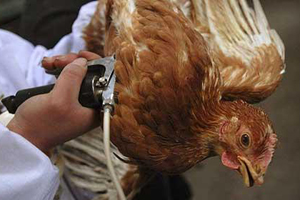Flu season could see re-emergence of bird flu virus

In light of the upcoming flu season, the FAO have issued a new warning to the international community that the H7N9 and H5N1 avian influenza viruses continue to pose a serious threat to human and animal health.
“The world is more prepared than ever before to respond to bird flu viruses in light of a decade of work on H5N1 and the recent response to H7N9,” said FAO Chief Veterinary Officer Juan Lubroth at a joint meeting with United States Agency for International Development (USAID), the World Health Organization (WHO) and the World Organisation for Animal Health (OIE).
Heads of FAO Reference Laboratories in Australia, the People’s Republic of China and the United States of America were also in attendance, along with representatives from the Centers for Disease Control and Prevention and the United States Department of Agriculture.
“However, constant vigilance is required,” Lubroth said. “Bird flu viruses continue to circulate in poultry. Efforts must continue and be strengthened, not only in affected countries, but also in neighbouring states and areas with strong trade linkages. This is especially true for H7N9 since it causes no clinical signs in birds and is therefore very difficult to detect in poultry.”
Along these lines, FAO has committed $2 million of emergency funding supplemented by over US$5 million from USAID to kick-start H7N9 response efforts. USAID support has enabled FAO to help countries at risk dramatically improve surveillance capacities.
“Several at-risk countries previously unable to pick up the virus can now accurately detect H7N9,” explained Lubroth. “Identifying the virus with consistency is critical to targeting control efforts and reducing spread.”
Dennis Carroll, Director of USAID’s Emerging Threats Programme, added, “The early detection and excellent characterisation of the H7N9 virus by Chinese experts has created an unprecedented opportunity to mount a coordinated effort to stop the further spread of the virus – and thwart a possible global event.
Significant progress over the past decade in forging national and international partnerships and validating interventions for control of avian influenza can be immediately adapted to addressing the threat posed by the H7N9 virus.”
Surveillance is key
FAO and USAID stress that more work is required. In the short term this includes continued, targeted surveillance and trace back throughout the production and marketing system, contingency planning and compensation scheme development.
“The emergence of the H7N9 virus serves as yet another reminder that new disease threats are not the exception, but a predictable consequence of events occurring at the human-animal interface,” said Carroll.
“It is important we continue to monitor future threats while at the same time improving the practices and behaviours associated with livestock production and marketing that can make it easier for diseases to emerge and affect animals and people,” he said.
“Surveillance is key, and with support from key partners like USAID, we’re making progress,” said Lubroth. “In addition to helping countries detect the virus, we need to make sure authorities can trace back the virus to its points of origin and better understand how the virus is circulating so as to design effective control actions. Where appropriate we need to help governments put together contingency plans for the possible detection of the virus and compensation schemes for assisting those affected by control efforts.”













